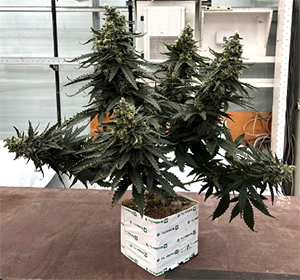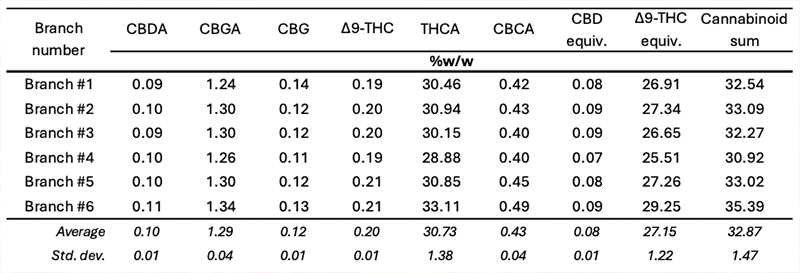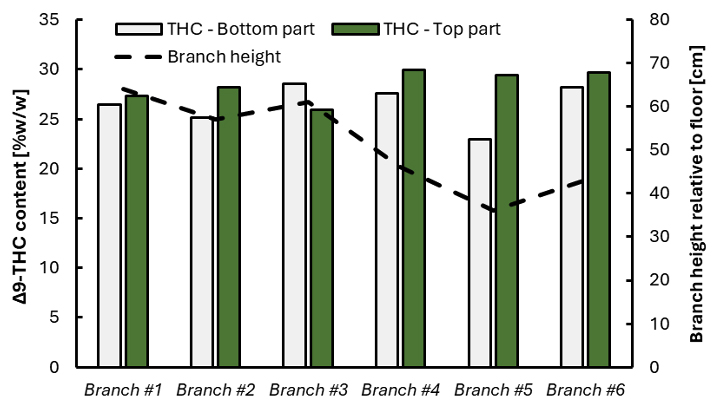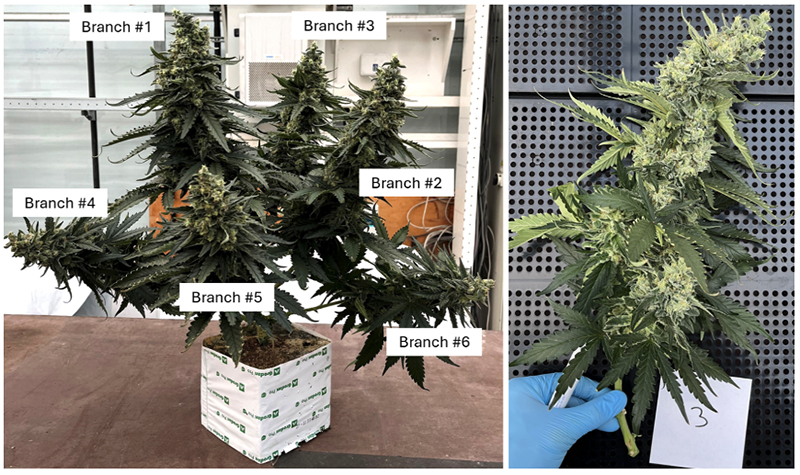Spatial distribution of cannabinoid content within a plant
Background information:
Cultivators and Brightlabs are both members of the in the Cultivation for Compounds (CfC) consortium. The consortium, consisting of large companies within the horticultural industry, was founded to facilitate research on the cultivation of medical cannabis and its beneficial compounds.
The CfC has found a reliable and consistent partner in Brightlabs for its analyses on the quality of the produced flower. In the CfC’s independently developed sampling protocols, a mixed sample is collected from all parts of the plant before the sample is sent for analysis. To verify the correctness of the protocol for our cultivation set-up, questions arose regarding the distribution of cannabinoids through different parts of the plant. As it is known that cannabinoids levels can differ depending on the position of the flower, cultivar, lightning and many other variables. Therefore it is of importance to get insight into these differences so they can take into account.
Goal:
Verify the sampling protocol developed for CfC’s specific cultivation set-up
Experimental setup:
A representative plant from the reference treatment from the winter 2023 research cultivation cycle was selected for further analysis. The plant was grown in a high-

tech greenhouse in the Netherlands, where the CfC consortium performs the experiments. The greenhouse is equipped with a gutter cultivation system, pressure compensated drip irrigation, and an active climate control system including CO2 supplementation. A dynamic LED system ensured a consistent light intensity of 1000 µmol/m2/s on the crop. The reference treatment was grown on stone wool.
The plants were topped at 8 days into the vegetative phase and kept on 6 branches. The vegetative phase lasted for 10 days and the flowering phase for 8 weeks. A pruning step was included 2 weeks after the switch to short-day. Netting was used to support the heavy flower bearing branches. This strategy results in a compact crop with an even canopy.
The variety used was “OG Blitz”, a variety that produces dense flower clusters with THC percentages between 25 and 30%.
At the moment of harvest, the plant size, weight, and location of its branches were noted. Then, for each of the 6 branches, the branches were split in the middle and the flowers were labelled as belonging to either the top or bottom half of their branch. The flowers were labelled and dried separately. After drying, the flower samples were sent to Brightlabs for analysis on cannabinoid content.
Results:
Brightlabs analysed the samples for the presence of 17 different cannabinoids. The cannabinoids below the least observable quantity have been omitted from the discussion. The column “Δ9-THC equiv.” is calculated by multiplying the amount of THCA by 0.877 + the amount of Δ9-THC.

The potency of the OG Blitz variety is proven with consistent THC percentages between 25 and 30%. The average of Δ9-THC over all branches comes down to 27.2 ± 1.2 %, meaning less than 10% deviation in Δ9-THC content. The same trend is reflected in the sum of all measured cannabinoids in the last column. However, the maximum difference between the Δ9-THC is about 4%, showing that the total plant average is different from the potency of single flowers. Meaning that a single flower should not be considered as representative for the batch or even the plant. Giving thought that making a good mixture is key in creating a representative sample for analysis.

Screenshot
Next, we will take a closer look at the data by separating the branch averages into their top and bottom sections. Now we can see that there are only minor differences in Δ9-THC between the top and bottom section for all branches (except branch #5). On the secondary axis, the height of the top of the branch relative to the floor is plotted. There is no clear relation between the height of the branch and the average Δ9-THC content in the flower. Interestingly, the Δ9-THC content of the top part of the branches seems to increase slightly when the branch height decreases. The Δ9-THC content of the bottom part of the branches seems to remain constant, except for branch #5, no matter the height of the branch relative to the floor.
Discussion:
The difference in height from the floor between the highest and lowest branch was only 28 cm, meaning that a very compact structure was achieved (photo on the left). Also, with the pruning and trellising strategy, equal flower development between the top and bottom parts of branches was realized (atleast visually) (photo on the right).

In total, 12 analyses (2 per branch, 1 for the top and 1 for the bottom section) were conducted on this plant. The analyses showed consistent Δ9-THC percentages, proving the effectiveness and consistency of the cultivation strategy as well as the analysis techniques. These analyses prove that the difference in cannabinoid content of flowers from different parts of the plant is relatively small, less than 10% deviation from the plant average, in our cultivation system. Nevertheless, the highest difference in Δ9-THC content was 4% between branches, showing the necessity of creating a representative mixed sample for analysis instead of relying on a single flower.

